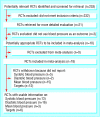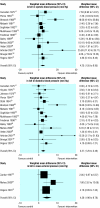Blood pressure control by home monitoring: meta-analysis of randomised trials
- PMID: 15194600
- PMCID: PMC478224
- DOI: 10.1136/bmj.38121.684410.AE
Blood pressure control by home monitoring: meta-analysis of randomised trials
Erratum in
- BMJ. 2004 Aug 28;329(7464):499
Abstract
Objective: To determine the effect of home blood pressure monitoring on blood pressure levels and proportion of people with essential hypertension achieving targets.
Design: Meta-analysis of 18 randomised controlled trials.
Participants: 1359 people with essential hypertension allocated to home blood pressure monitoring and 1355 allocated to the "control" group seen in the healthcare system for 2-36 months.
Main outcome measures: Differences in systolic (13 studies), diastolic (16 studies), or mean (3 studies) blood pressures, and proportion of patients achieving targets (6 studies), between intervention and control groups.
Results: Systolic blood pressure was lower in people with hypertension who had home blood pressure monitoring than in those who had standard blood pressure monitoring in the healthcare system (standardised mean difference 4.2 (95% confidence interval 1.5 to 6.9) mm Hg), diastolic blood pressure was lower by 2.4 (1.2 to 3.5) mm Hg, and mean blood pressure was lower by 4.4 (2.0 to 6.8) mm Hg. The relative risk of blood pressure above predetermined targets was lower in people with home blood pressure monitoring (risk ratio 0.90, 0.80 to 1.00). When publication bias was allowed for, the differences were attenuated: 2.2 (-0.9 to 5.3) mm Hg for systolic blood pressure and 1.9 (0.6 to 3.2) mm Hg for diastolic blood pressure.
Conclusions: Blood pressure control in people with hypertension (assessed in the clinic) and the proportion achieving targets are increased when home blood pressure monitoring is used rather than standard blood pressure monitoring in the healthcare system. The reasons for this are not clear. The difference in blood pressure control between the two methods is small but likely to contribute to an important reduction in vascular complications in the hypertensive population.
Figures




References
-
- Collins R, Peto R, MacMahon S, Hebert P, Fiebach NH, Eberlein KA, et al. Blood pressure, stroke and coronary heart disease. II. Short term reductions in blood pressure: overview of randomised drug trials in their epidemiological context. Lancet 1990;335: 827-38. - PubMed
-
- MacMahon S, Peto R, Cutler J, Collins R, Sorlie P, Neaton J, et al. Blood pressure, stroke and coronary heart disease. I. Effect of prolonged differences in blood pressure: evidence from nine prospective observational studies corrected for the regression dilution bias. Lancet 1990;335: 765-74. - PubMed
-
- Prospective Studies Collaboration. Age-specific relevance of usual blood pressure to vascular mortality: a meta-analysis of individual data for one million adults in 61 prospective studies. Lancet 2002;360: 1903-13. - PubMed
-
- Prospective Studies Collaboration. Cholesterol, diastolic blood pressure, and stroke: 13,000 strokes in 450,000 people in 45 prospective cohorts. Lancet 1995;346: 1647-53. - PubMed
-
- Primatesta P, Brookes M, Poulter NR. Improved hypertension management and control: results from the health survey for England 1998. Hypertension 2001;38: 827-32. - PubMed
Publication types
MeSH terms
LinkOut - more resources
Full Text Sources
Medical
